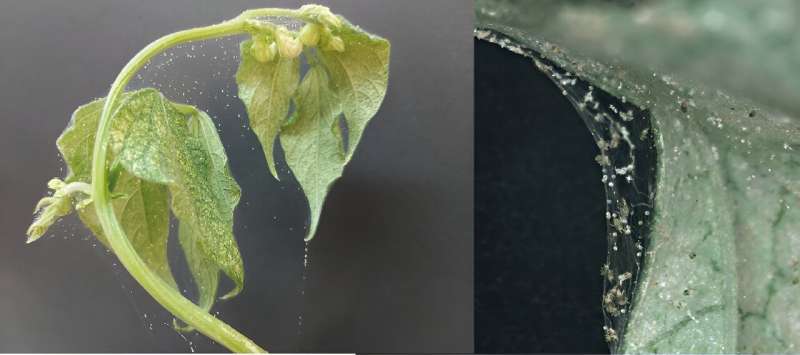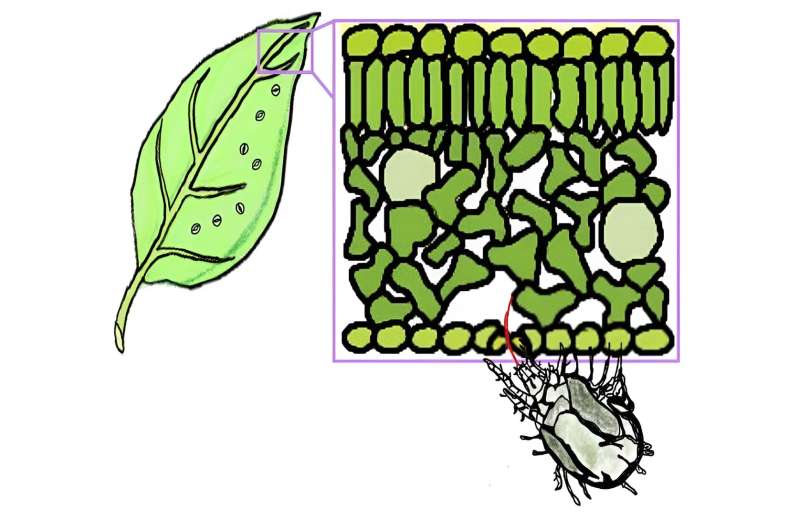This article has been reviewed according to Science X's editorial process and policies. Editors have highlighted the following attributes while ensuring the content's credibility:
fact-checked
trusted source
proofread
Research discovers plants utilize drought stress hormone to block snacking spider mites

Recent findings that plants employ a drought-survival mechanism to also defend against nutrient-sucking pests could inform future crop breeding programs aimed at achieving better broadscale pest control.
Using an advanced fluorescent biosensor (ABACUS2) that can detect tiny changes in plant hormone concentrations at the cellular scale, scientists saw that abscisic acid (ABA), usually linked with drought response, started closing the plant's entry gates within 5 hours of being infested with spider mites.
Microscopic leaf pores (stomata) are important for gas exchange but are also the major sites for water loss. When there is a water shortage, plants act to conserve water by producing the drought stress hormone ABA to close their stomata.
Coincidentally, the closure of stomata also obstructs the preferred entry points for nutrient-sucking pests like spider mites. The two-spotted spider mite is one of the most economically damaging pests—it's not fussy and attacks a broad range of more than 1000 plants, including 150 crops.
Barely visible to the naked eye, these tiny pests pierce and then suck dry plant cells. They can build up to enormous numbers very quickly and can be one of the most destructive pests in the garden and horticulture industry, spoiling house plants and reducing yields of vegetables, fruit and salad crops.
There has been debate about ABA's role in pest resistance. Initially, it was noticed that stomata close when plants are attacked by nutrient-sucking pests, leading to various hypotheses, including that this closure could be a plant response to losing water due to the pests' feeding or even that the pests act to close stomata to prevent plants from sending distress volatiles to pest predators.
In a collaboration between the Centre for Plant Biotechnology and Genomics (CBGP) in Spain and Sainsbury Laboratory Cambridge University (SLCU), researchers studying how thale cress (Arabidopsis thaliana) responds to the two-spotted spider mite (Tetranychus urticae) have determined the plant leaps into action almost immediately, employing the same hormone as for drought to also block spider mites from penetrating plant tissues and, as a result, significantly reducing pest damage.
The findings published in Plant Physiology found the peak closure of stomata is achieved within a time frame of 24 to 30 hours.

"Open stomata are natural apertures where pests like aphids and mites insert their specialized feeding structures, called stylets, to pierce and then suck out the nutrient rich contents from individual sub-epidermal cells," said Irene Rosa-Díaz, who carried out the spider mite experiments at SLCU and CBGP during her Ph.D. with Professor Isabel Diaz at the Centro de Biotecnología y Genómica de Plantas, Universidad Polytécnica de Madrid, and National Institute of Agricultural and Food Research and Technology (UPM-INIA) .
"We were able to show mite infestation induced a rapid stomatal closure response, with the plant hormone ABA rising in the leaf tissues—highest in stomatal and vascular cells, but also all other leaf cells measured. We showed through multiple different experiments that stomatal closure hinders mites.
"Plants that were pre-treated with ABA to induce stomatal closure and then infested with mites showed decreased mite damage, while ABA-deficient mutant plants where stomata cannot close well and plants that have a more stomata are more susceptible to mites."
Alexander Jones' research group at SLCU develops in vivo biosensors that are revealing hormone dynamics in plants at unprecedented resolution, including ABACUS2 that quantified cellular ABA in these mite experiments.
Dr. Jones said the study highlights the important interactions between biotic and abiotic stresses in plants, "Early warning cues from mite feeding induces a cascade of immune signaling molecules, including jasmonic acid (JA) and salicylic acid (SA), among other chemical responses. Together, these results show that ABA accumulation and stomatal closure are also key defense mechanisms employed to reduce mite damage.
"The next step is to investigate what the initial mite-produced signal is that the plant is detecting that then results in ABA accumulation. The biochemical mechanisms being used by the plant as signals of pest attack could be anything, including mite feeding vibrations, mite salivary proteins, chemicals produced by the mites or mite activity, direct cell damage (wounds) or other molecules associated with the mites.
"Identifying the initial triggers could potentially be used to develop new crop treatments to arm the plants ahead of predicted pest infestations. Importantly, efforts to select for plants with altered stomatal traits, which already must balance a photosynthesis vs. water conservation trade-off, could also consider resistance to damaging pests."
More information: Irene Rosa-Díaz et al, Spider mite herbivory induces an abscisic acid-driven stomatal defense, Plant Physiology (2024). DOI: 10.1093/plphys/kiae215
Provided by University of Cambridge

















